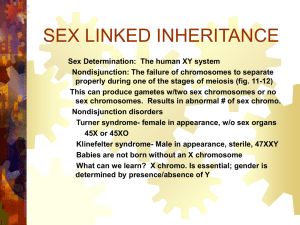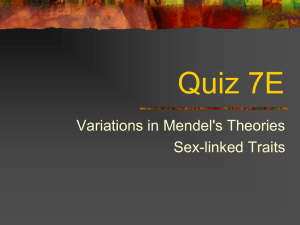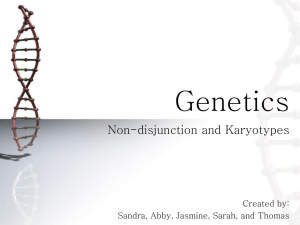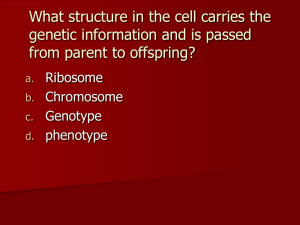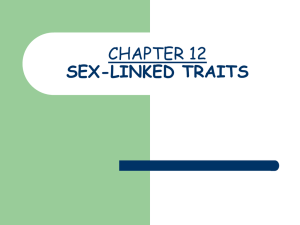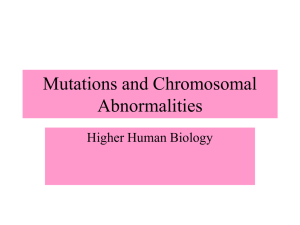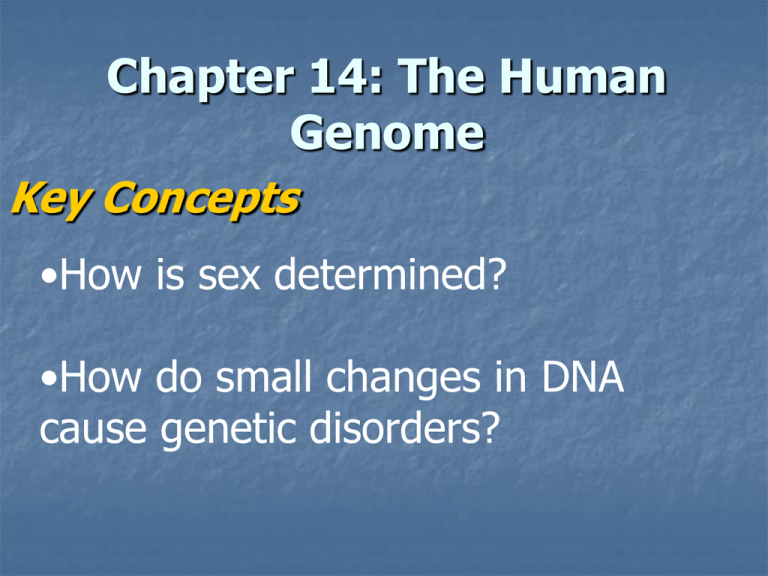
Chapter 14: The Human
Genome
Key Concepts
•How is sex determined?
•How do small changes in DNA
cause genetic disorders?
Content standards
2f: The role of chromosomes in
determining and individual’s sex.
3a: Predicting phenotypes when
parents and mode of inheritance
is known (autosomal or sex
linked).
3c: Pedigrees
Around 1890, scientists observed
that male and female
chromosomes were the same,
except for one.
These
2 unmatched
chromosomes are now
known as the
sex chromosomes.
26-1
The non-sex
chromosomes
are called
autosomes.
26-1
In fruit flies, as in humans,
the 2 female chromosomes
(X) look the same, the male
chromosome (Y) looks
different.
26-1
XX
Females have
2 X chromosomes
XY
Males have
1 X and 1 Y
chromosome
The sex of drosophila and
humans is determined at
fertilization.
Who determines the sex of
offspring? (male or female)
26-1
Sex-linked Traits
A
trait that is controlled by a
gene found on the sex
chromosomes.
Chance of showing the trait is
determined by the sex of the
individual.
26-1
14-2: Human Chromosomes
Sex-linked Traits, cont’d
Most
sex-linked traits are
determined by genes found
on the X chromosome, NOT
the Y chromosome.
14-2
Sex-linked traits in humans
Many
human conditions and
diseases are caused by abnormal
recessive alleles of certain genes.
Several are sex-linked.
Examples:
blindness
Hemophilia
Muscular dystrophy
?
Color
14-2
Sex-linked Genes
Males have just one X chromosome.
Thus, all X-linked alleles are
expressed in males, even if they are
recessive.
So . . . Sex-linked conditions show up
more in males than females.
Color
blindness
14-2
Color
blindness
14-2
Color
blindness
Red-green cb.
14-2
Color
blindness
14-2
Color
blindness
http://www.blc.arizona.edu/courses/181gh/rick/human_genetics/pedigree.html
R
X
Xr
R
X
Y
14-2
http://www.blc.arizona.edu/courses/181gh/rick/human_genetics/pedigree.html
X Inactivation in female mammals
14-2
14-2
Chromosomal Disorders
Nondisjunction
If nondisjunction occurs, abnormal
numbers of chromosomes may find
their way into gametes, and a
disorder of chromosome numbers
may result.
14-2
Example:
Down
syndrome
Other nondisjunction disorders:
Klinefelter (XXY)
Down’s Syndrome (Trisomy 21)
Turner’s syndrome (single X)
Edward’s syndrome (Trisomy 18)
Patau Syndrome (Trisomy 13)


